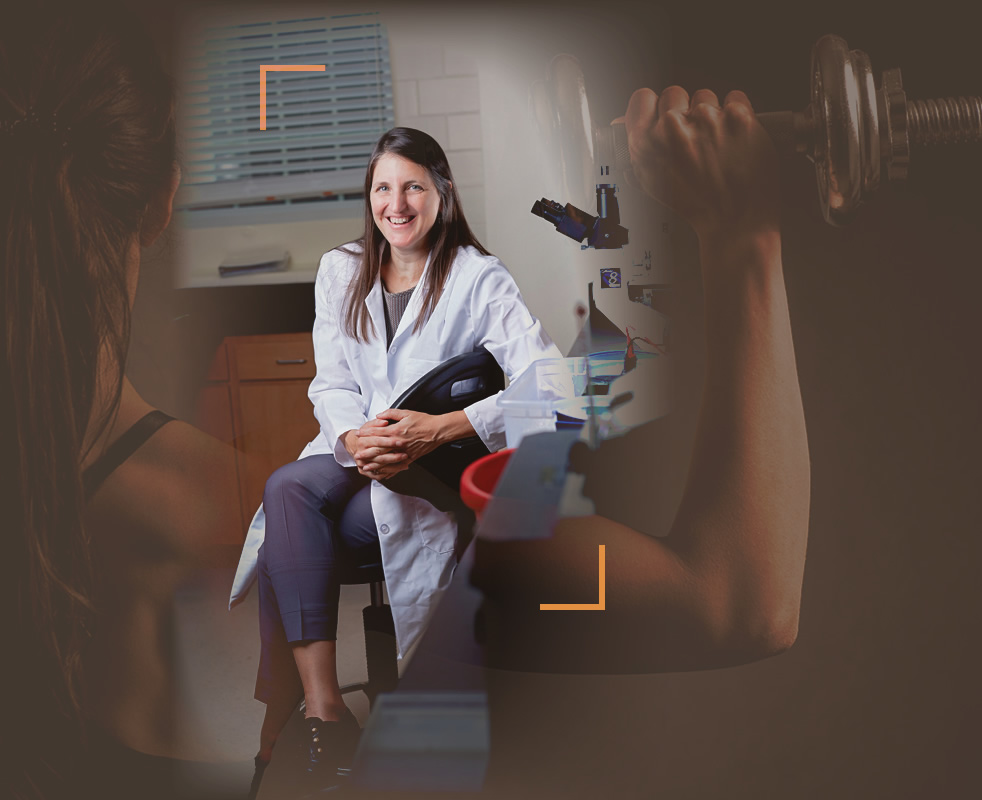 HHP - Update me in site_config > General Configuration
HHP - Update me in site_config > General Configuration
HHP’s Beth Barton is studying a specific component of muscle growth to understand its impact on metabolic health and wellness.

For many Americans, trying to stay physically fit is a way of life. Combined, the weight loss and fitness industries collect over $80 billion in revenue each year. Fitness models, transformation pictures and bodybuilders have flooded social media, causing more and more Americans to focus on staying in the best shape possible. But a study by HHP researchers is revealing that these long hours spent in the gym might not just be for show.
Millions of Americans suffer from some form of muscular atrophy, a decrease in the body’s amount of natural muscle, impacting the way we live and work. Dr. Elisabeth Barton, an HHP professor in the Department of Applied Physiology and Kinesiology, is attempting to discover how building muscle can not only protect against these negative metabolic effects, but also help support an active lifestyle. Barton and her team work to determine how muscle metabolism is influenced by one specific protein.
Insulin Growth Factor-1 (IGF-1) is a protein found in all tissues. The molecule circulates in the bloodstream and its presence causes skeletal muscle to grow. Muscle makes its own IGF-1, and stores it to promote growth, but work in Barton’s lab suggests that it is also important for metabolism. A major aim of Barton’s research was to ask what would happen to muscle if IGF-1 was removed from these tissues.
“Building muscle is important for metabolic health,” Barton said. “We wanted to see the consequences that would arise if the protein was lacking.”
To test this, Barton and her team designed a mouse model where they could turn off IGF-1 in muscles. IGF-1 was not present from birth and “silenced” during the development of young adult male mice, the two greatest periods for muscle growth.
When IGF-1 was absent from birth, the mice had smaller muscles. However, as adults grew over time, male mice ballooned in size, developing obesity and other metabolic complications. Even more surprising was that these changes also occurred in adult mice following a brief loss of IGF-1 in the muscles.
“The maintenance of muscle mass is not just for show or mobility,” Barton said. “Maintaining muscle mass may even help counter diseases such as diabetes.”
Natural IGF-1 deletions are only found in a handful of cases, including in patients with some forms of dwarfism. But according to Barton, levels of IGF-1 start to decline as a person ages, reducing their ability to keep muscle mass and maintain metabolic health.
Movement can help counteract the loss of the protein over time, Barton said. Recent research has shown that regular exercise can even help maintain its levels in the body, helping individuals who weightlift regularly to put on and keep their muscle gains.
Barton said that further steps should be taken to confirm the protein’s significance in human muscle development. Her research team plans to use the mouse model to explore why there are differences in muscle loss and IGF-1 production between sexes and age groups.
Future studies hope to show that resistance training may keep muscle decline at bay. With further research into the IGF-1 protein, many may soon learn that it is not too late to take the first steps towards preserving their physical health.
“There are many new and exciting questions that we can ask ourselves as we take the next steps with this study,” Barton said.